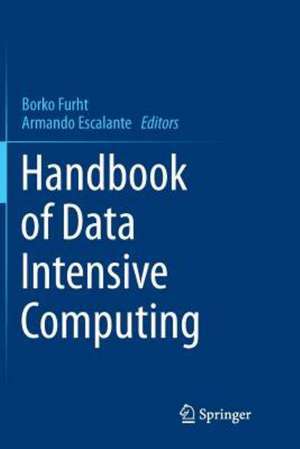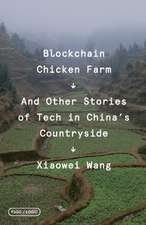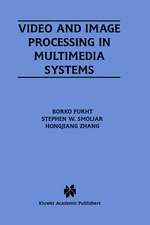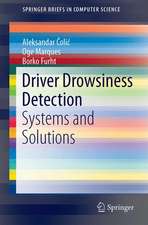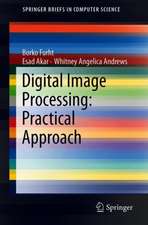Handbook of Data Intensive Computing
Editat de Borko Furht, Armando Escalanteen Limba Engleză Paperback – 3 mar 2014
Handbook of Data Intensive Computing is designed as a referencefor practitioners and researchers, including programmers, computer and system infrastructure designers, and developers. This book can also be beneficial for business managers, entrepreneurs, and investors.
| Toate formatele și edițiile | Preț | Express |
|---|---|---|
| Paperback (1) | 727.80 lei 6-8 săpt. | |
| Springer – 3 mar 2014 | 727.80 lei 6-8 săpt. | |
| Hardback (1) | 1019.17 lei 6-8 săpt. | |
| Springer – 9 dec 2011 | 1019.17 lei 6-8 săpt. |
Preț: 727.80 lei
Preț vechi: 909.74 lei
-20% Nou
Puncte Express: 1092
Preț estimativ în valută:
139.28€ • 145.23$ • 115.76£
139.28€ • 145.23$ • 115.76£
Carte tipărită la comandă
Livrare economică 21 martie-04 aprilie
Preluare comenzi: 021 569.72.76
Specificații
ISBN-13: 9781489999191
ISBN-10: 1489999191
Pagini: 812
Ilustrații: XVIII, 794 p.
Dimensiuni: 155 x 235 x 43 mm
Greutate: 1.12 kg
Ediția:2011
Editura: Springer
Colecția Springer
Locul publicării:New York, NY, United States
ISBN-10: 1489999191
Pagini: 812
Ilustrații: XVIII, 794 p.
Dimensiuni: 155 x 235 x 43 mm
Greutate: 1.12 kg
Ediția:2011
Editura: Springer
Colecția Springer
Locul publicării:New York, NY, United States
Public țintă
Professional/practitionerCuprins
PART I ARCHITECTURES AND SYSTEMS.- High Performance Network Architectures for Data Intensive Computing.- Architecting Data-Intensive Software Systems.- ECL: A High-Level Programming Language for Data-Intensive Supercomputing.- Scalable Storage for Data-Intensive Computing.- Computation and Storage Trade-off for Cost-Effective Storage of Scientific Datasets in the Cloud.- PART II TECHNOLOGIES AND TECHNIQUES.- Load Balancing Techniques for Data Intensive Computing.- Resource Management for Data Intensive Clouds Through Dynamic Federation: A Game Theoretic Approach.- SALT: Scalable Automated Linking Technology for Data Intensive Computing.- Parallel Processing, Multiprocessors and Virtualization in Data-Intensive Computing.- Challenges in Data Intensive Analysis and Visualization at Scientific Experimental User Facilities.- Large-Scale Data Analytics Using Ensemble Clustering.- Specification of Data Intensive Applications with Data Dependency and Abstract Clocks.- Ensemble Feature RankingMethods for Data Intensive Computing Applications.- Record Linkage Methodology and Applications.- Semantic Wrapper: Concise Semantic Querying of Legacy Relational Databases.- PART III SECURITY.- Security in Data Intensive Computing Systems.- Data Security and Privacy in Data-Intensive Supercomputing Clusters.- Information Security in Large Scale Distributed Systems.- Privacy and Security Requirements of Data Intensive Applications in Clouds.- PART IV APPLICATIONS.- On the Processing of Extreme Scale Datasets in the Geosciences.- Parallel Earthquake Simulations on Large-scale Multicore Supercomputers.- Data Intensive Computing in Bioinformatics: A Biomedical Case Study in Gene Selection and Filtering.- Design Space Exploration for Efficient Data Intensive Computing on SoCs.- Discovering Relevant Entities in Large-scale Social Information Systems.-Geospatial Data Management with Terrafly.- An Application for Processing Large and Non-uniform Media Objects on MapReduce-based Clusters.- Feature Selection Algorithms for Mining High-Dimensional DNA Microarray Data.- Application of Random Matrix Theory to Analyze Biological Data.- Keyword Search on Large Relational Databases: an OLAP-Oriented Approach.- A Distributed Publish/Subscribe System for Large Scale Sensor Networks.
Recenzii
From the reviews:
“The material is written by experts from nearly 40 institutions, including academia, industry, and government; they are mostly from the US, but also from Europe, Asia, and Australia. … The editors make readers aware of the scale of data generated from a variety of sources, which require immediate comprehensive analyses. … The value of this book might be in collecting papers that focused on the issues of big data, so interested parties can have a handy overview of related problems and prospective solutions.” (Janusz Zalewski, ACM Computing Reviews, September, 2012)
“The material is written by experts from nearly 40 institutions, including academia, industry, and government; they are mostly from the US, but also from Europe, Asia, and Australia. … The editors make readers aware of the scale of data generated from a variety of sources, which require immediate comprehensive analyses. … The value of this book might be in collecting papers that focused on the issues of big data, so interested parties can have a handy overview of related problems and prospective solutions.” (Janusz Zalewski, ACM Computing Reviews, September, 2012)
Notă biografică
Caracteristici
Describes and evaluates the current state-of-the-art in new field Presents current systems, and applications from main research labs in this new explosive field Written at a level that business managers, entrepreneurs, and investors will find beneficial Includes supplementary material: sn.pub/extras
